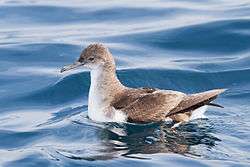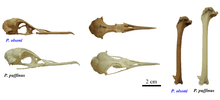Puffinus
| Puffinus | |
|---|---|
 | |
| Fluttering shearwater, Puffinus gavia | |
| Scientific classification | |
| Kingdom: | Animalia |
| Phylum: | Chordata |
| Class: | Aves |
| Order: | Procellariiformes |
| Family: | Procellariidae |
| Genus: | Puffinus Brisson, 1760 |
| Species | |
|
See text | |
| Synonyms | |
Puffinus is a genus of seabirds in the order Procellariiformes. It comprises about 20 small to medium-sized shearwaters. Two other shearwater genera are named: Calonectris, which comprises three or four large shearwaters, and Ardenna with another seven species (formerly often included within Puffinus).
Puffinus is a New Latin loanword based on the English "puffin". The original Latin term for shearwaters was usually the catchall name for sea-birds, mergus.[1] "Puffin" and its variants, such as poffin, pophyn and puffing,[2] referred to the cured carcass of the fat nestling of the shearwater, a former delicacy.[3] The original usage dates from at least 1337, but from as early as 1678 the term gradually came to be used for another, unrelated, seabird, the Atlantic puffin, an auk.[2] The current English name was first recorded in 1835 and refers to the former nesting of this species on the Isle of Man.[4]
The taxonomy of this group is the cause of much debate, and the number of recognised species varies with the source.
The species in this group are long-winged birds, dark brown or black above, and white to dark brown below. They are pelagic outside the breeding season. They are most common in temperate and cold waters.
These tubenose birds fly with stiff wings, and use a shearing flight technique to move across wave fronts with the minimum of active flight. Some small species, such as the Manx shearwater, are cruciform in flight, with their long wings held directly out from their bodies.
Many are long-distance migrants, perhaps most spectacularly the sooty and short-tailed shearwaters, which perform migrations of 14,000 km or more each year.
Puffinus shearwaters come to islands and coastal cliffs only to breed. They are nocturnal at the colonial breeding sites, preferring moonless nights to minimise predation. They nest in burrows and often give eerie contact calls on their night-time visits. They lay a single white egg.
They feed on fish, squid and similar oceanic food. Some will follow fishing boats to take scraps, notably the sooty shearwater; these species also commonly follow whales to feed on fish disturbed by them.
Taxonomy
Traditionally, Puffinus has been grouped with the Procellaria and Calonectris shearwaters. However, more recent results[5][6][7] have determined that the genus is apparently paraphyletic and while in part very close to Calonectris, forms a clade with the genera Pseudobulweria and Lugensa, which were formerly presumed to be gadfly petrels, and can be divided in what has been called the "Puffinus" and the "Neonectris" group after notable species; the latter has been separated as a distinct genus named Ardenna.[8][9] The former is taxonomically confusing, with species having been split and remerged in the last years.[6][7]

The genus Puffinus contains the following species:[10]
- Christmas shearwater, Puffinus nativitatis
- Manx shearwater, Puffinus puffinus
- Yelkouan shearwater, Puffinus yelkouan
- Balearic shearwater, Puffinus mauretanicus
- Bryan's shearwater, Puffinus bryani
- Black-vented shearwater, Puffinus opisthomelas
- Townsend's shearwater, Puffinus auricularis
- Newell's shearwater, Puffinus newelli
- Rapa shearwater, Puffinus myrtae
- Fluttering shearwater, Puffinus gavia
- Hutton's shearwater, Puffinus huttoni
- Audubon's shearwater, Puffinus lherminieri
- Persian shearwater, Puffinus persicus
- Tropical shearwater or Baillon's shearwater, Puffinus bailloni
- Galápagos shearwater, Puffinus subalaris
- Bannerman's shearwater, Puffinus bannermani
- Heinroth's shearwater, Puffinus heinrothi
- Little shearwater, Puffinus assimilis
- Subantarctic shearwater, Puffinus elegans
- Barolo shearwater, Puffinus baroli
- Boyd's shearwater, Puffinus boydi
Fossil record

Several fossil species which became extinct long ago are also known. The proportion of larger ("Neonectris") species apparently was larger before the Pliocene, i.e. before marine mammals diversified:
- "Puffinus" group
- Menorcan shearwater, Puffinus sp. (prehistoric) – possibly extirpated population of extant species; tentatively placed in this group
- Dune shearwater or Hole's shearwater, Puffinus holeae (prehistoric)
- Lava shearwater or Olson's shearwater, Puffinus olsoni (prehistoric) – tentatively placed in this group
- Bermuda shearwater, Puffinus parvus (extinct) – tentatively placed in this group
- Scarlett's shearwater, Puffinus spelaeus (prehistoric)
- Puffinus tedfordi (Pleistocene of western North America)
- Puffinus nestori (Late Pliocene/Early Pleistocene of Ibiza)
- "Neonectris" group
- Puffinus conradi (Early Miocene of Calvert County, US)
- Puffinus cf. tenuirostris (Late Miocene/Early Pliocene of Lee Creek Mine, US)
- Puffinus sp. 1 (Late Miocene/Early Pliocene of Lee Creek Mine, US)
- Puffinus sp. 2 (Late Miocene/Early Pliocene of Lee Creek Mine, US)
- Puffinus pacificoides (Pleistocene of Saint Helena, Atlantic)
- Unassigned
- ?Puffinus raemdonckii (Early Oligocene of Belgium) – formerly in Larus
- Puffinus micraulax (Early Miocene of C Florida, US) – probably "Puffinus" group
- Puffinus sp. (Early Miocene of Calvert County, US)[11]
- Puffinus sp. (Early Pliocene of South Africa)[12]
- Puffinus felthami (Pleistocene of W North America)
- Puffinus kanakoffi (Pleistocene of W North America)
"Puffinus" arvernensis (Early Miocene of France) is now considered a primitive albatross of the fossil genus Plotornis.
See also
| Wikimedia Commons has media related to Puffinus. |
| Wikispecies has information related to: Puffinus |
References
- ↑ Thompson, D'Arcy Wentworth (1918). "The Birds of Diomede". Classical Review. 32 (5/6): 92–96. doi:10.1017/S0009840X00011549. JSTOR 699721.
- 1 2 "Puffin". Oxford English Dictionary. Oxford University Press. Retrieved 14 December 2014.(subscription required)
- ↑ Jobling, James A (2010). The Helm Dictionary of Scientific Bird Names. London: Christopher Helm. p. 323. ISBN 978-1-4081-2501-4.
- ↑ "Manx". Oxford English Dictionary. Oxford University Press. Retrieved 14 December 2014.(subscription required)
- ↑ Austin, Jeremy J. (1996). "Molecular Phylogenetics of Puffinus Shearwaters: Preliminary Evidence from Mitochondrial Cytochrome b Gene Sequences". Molecular Phylogenetics and Evolution. 6 (1): 77–88. doi:10.1006/mpev.1996.0060. PMID 8812308.
- 1 2 Heidrich, Petra; Amengual, José F. & Wink, Michael (1998). "Phylogenetic relationships in Mediterranean and North Atlantic shearwaters (Aves: Procellariidae) based on nucleotide sequences of mtDNA" (PDF). Biochemical Systematics and Ecology. 26 (2): 145–170. doi:10.1016/S0305-1978(97)00085-9.
- 1 2 Austin, Jeremy J.; Bretagnolle, Vincent & Pasquet, Eric (2004). "A global molecular phylogeny of the small Puffinus shearwaters and implications for systematics of the Little-Audubon's Shearwater complex". Auk. 121 (3): 847–864. doi:10.1642/0004-8038(2004)121[0847:AGMPOT]2.0.CO;2.
- ↑ Penhallurick, John & Wink, Michael (2004). "Analysis of the taxonomy and nomenclature of the Procellariformes based on complete nucleotide sequences of the mitochondrial cytochrome b gene". Emu. 104 (2): 125–147. doi:10.1071/MU01060.
- ↑ Remsen, J.V. (September 2014). "Proposal (647) to South American Classification Committee: Spilt Ardenna from Puffinus". South American Classification Committee. Retrieved 23 January 2016.
- ↑ Gill, Frank; Donsker, David (eds.). "Loons, penguins, petrels". World Bird List Version 5.4. International Ornithologists' Union. Retrieved 23 January 2016.
- ↑ Wetmore, Alexander (1926). "Observations on fossil birds described from the Miocene of Maryland" (PDF). Auk. 43 (4): 462–468. doi:10.2307/4075132.
- ↑ Olson, Storrs L. (1985): Section X, H, 2. Procellariidae. In: Farner, D.S.; King, J.R. & Parkes, Kenneth C. (eds.): Avian Biology 8: 210–211. Academic Press, New York.
Further reading
- Brooke, M. (2004): Albatrosses and Petrels Across the World. Oxford University Press, Oxford, UK. ISBN 0-19-850125-0